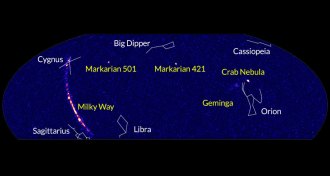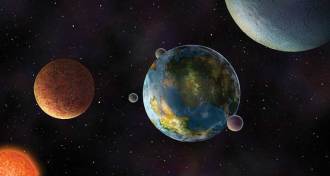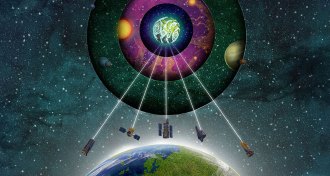Space
Sign up for our newsletter
We summarize the week's scientific breakthroughs every Thursday.
-
 Cosmology
CosmologyHow to make gravitational waves ‘sing’
A rapidly spinning black hole would make a unique pattern of gravitational waves when it sucks in a smaller companion.
-
 Astronomy
AstronomyTo find ET, look at who’s (maybe) looking at us
To listen for aliens, two astronomers suggest that we focus on stars whose inhabitants can see Earth periodically cross in front of our sun.
-
 Cosmology
CosmologyNew sky map charts previously unknown gamma-ray sources
A new map of the sky from the High-Altitude Water Cherenkov Observatory charts the cosmic origins of high-energy photons.
-
 Planetary Science
Planetary ScienceHow alien can a planet be and still support life?
Geoscientists imagine the unearthly mechanisms that could keep alien planets habitable.
-
 Astronomy
AstronomyNew telescopes will search for signs of life on distant planets
Researchers are coming up with creative ways to pick up biosignatures in far-away planetary atmospheres.
-
 Space
SpaceWill we know extraterrestrial life when we see it?
Desert varnish and certain minerals hint that life — here and elsewhere — may defy current criteria.
-
 Astronomy
AstronomyKepler telescope readies for new mission after communications scare
The Kepler space telescope has recovered from going into emergency mode and is now ready for its next planet-hunting mission.
-
 Astronomy
AstronomyKey sugar needed for life could have formed in space
Sugar that forms backbone of cell machinery can form on icy grains blasted by ultraviolet light from young stars.
-
 Astronomy
AstronomyPossible source of high-energy neutrino reported
Scientists may have found the cosmic birthplace of an ultra-high energy neutrino: a blazar 9 billion light years away.
-
 Astronomy
AstronomyThere’s far more to the galaxy than meets the eye
A new map of the galaxy as seen in submillimeter light reveals intricate details from nearby nebulas to the far-flung galactic center.
-
 Physics
PhysicsFaint gravitational waves could soon be on LIGO’s radar
In a few years, LIGO could detect hints of faint gravitational waves from black holes too far away to be seen directly.
-
 Astronomy
AstronomyOdd white dwarf found with mostly oxygen atmosphere
A white dwarf that has been stripped of its hydrogen and helium provides a rare peek inside the core of a dead massive star.